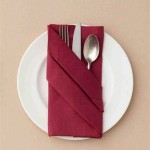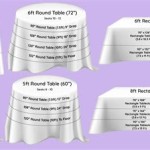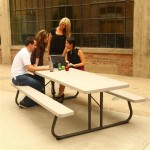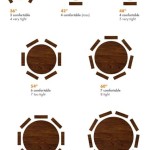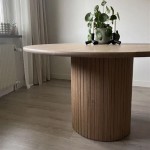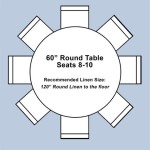How Long Should A Dining Table Be To Seat 8?
Determining the appropriate length of a dining table to comfortably seat eight people requires careful consideration of several factors. The dimensions should allow adequate personal space for each diner, accommodate serving dishes, and integrate seamlessly into the designated dining area. This article outlines the key considerations for selecting a dining table length suitable for seating eight, factoring in spatial requirements, table shape, and desired levels of comfort.
Understanding Per-Person Space Requirements
The most fundamental aspect of selecting a dining table involves understanding the individual space needed per person. A general guideline dictates that each diner requires approximately 24 inches (60 cm) of linear space along the table’s perimeter. This allocation allows adequate room for eating, prevents elbow-to-elbow contact with neighboring diners, and provides a comfortable, non-confined experience. When multiplied by the number of place settings, this figure offers a baseline estimate for the necessary table length.
Furthermore, the depth, or width, of the table is crucial. A minimum depth of 36 inches (90 cm) is commonly recommended. This provides ample space for place settings, serving dishes, and decorative elements. Insufficient table depth can lead to a cramped and disorganized dining experience, forcing diners to navigate limited space. A table depth exceeding 48 inches (120 cm) might prove excessive for conversation across the table, particularly with a larger group. Striking a balance between accessibility and conversational ease is key.
For eight people, assuming 24 inches of linear space per person, the minimum table length calculation is relatively straightforward. Four individuals will typically be seated on each side of a rectangular table. Therefore, a rectangular table designed to seat eight should ideally be at least 72 inches (180 cm) long. This minimum length is applicable when the table width is adequate, allowing comfortable placement of food and beverages.
It is important to note that this is a minimum recommendation. Depending on the specific dining habits and desired comfort levels, exceeding this minimum may be preferable. If large serving dishes are frequently used, or if a more spacious and luxurious dining experience is preferred, incrementally increasing the table length is advisable. Consider adding an additional 6-12 inches to the length to accommodate larger serving pieces and provide a more relaxed atmosphere.
When selecting the dining table, consider the chairs that will be used. Chairs with arms will require more space than armless chairs. The distance between the table legs also needs to be factored in. Ensure that the table legs do not obstruct comfortable seating.
Considering Table Shape and its Impact on Seating Capacity
The shape of the dining table significantly influences its seating capacity and spatial dynamics. While rectangular tables are the most common and readily available, other shapes, such as round, oval, and square, offer unique considerations and benefits. The choice of shape should align with the available space and desired aesthetic.
Round tables are often favored for smaller spaces and intimate gatherings, as they promote conversation and visual connection among diners. A round table intended for eight people should ideally have a diameter of at least 60 inches (150 cm). This measurement provides adequate space for each person, while ensuring that everyone can easily interact. Round tables maximize use of square footage, making them suitable for smaller dining areas.
Oval tables offer a blend of the rectangular and round shapes, combining the linear space of a rectangle with the conversational benefits of a circle. For seating eight guests, an oval table should be approximately 72 inches (180 cm) in length and 42 inches (105cm) in width. The elongated shape provides adequate seating while maintaining a relatively narrow profile, making it suitable for longer, narrower dining spaces.
Square tables can also accommodate eight individuals, but they require a larger footprint than rectangular or oval tables. To comfortably seat eight, a square table needs to be at least 60 inches (150cm) on each side. Square tables promote a sense of equality and balance, making them well-suited for formal dining rooms.
Extension tables, whether rectangular, oval, or round, provide flexibility by allowing the table to expand to accommodate larger groups. These tables incorporate leaves that can be added or removed to adjust the overall length. An extension table designed to seat eight should, in its collapsed state, be appropriately sized for a smaller group. When fully extended, the table should meet the length requirements previously mentioned for seating eight comfortably.
The shape of the room itself could influence the shape and size of the table. For example, a long, narrow room might benefit from a rectangular or oval table, while a square room might accommodate a square or round table more effectively. It's necessary to consider the overall dimensions and layout of the dining area to ensure the table fits proportionally and allows for easy movement around it.
Analyzing Room Size and Traffic Flow
Beyond the table dimensions themselves, the overall size of the dining room and the anticipated traffic flow within the space are crucial considerations. A spacious dining room can comfortably accommodate a larger table, while a smaller room may necessitate a more compact design. Adequate clearance around the table is essential to ensure ease of movement and prevent obstructions.
As a general rule, a minimum of 36 inches (90 cm) of clearance is recommended between the edge of the table and any nearby walls or furniture. This clearance allows individuals to comfortably pull out their chairs and move around the table without bumping into surrounding objects. If the dining area is also a primary thoroughfare, increasing this clearance to 48 inches (120 cm) or more is advisable.
Furthermore, consider the placement of other furniture within the dining room, such as sideboards, buffets, or display cabinets. These pieces should be positioned to avoid obstructing traffic flow and to maintain a comfortable and functional space. Measuring the available space and creating a scaled floor plan can be beneficial in visualizing the arrangement and ensuring that the table fits appropriately.
The height of the ceiling also affects the perception of spaciousness. Low ceilings may make a large table feel overwhelming, whereas high ceilings can accommodate a generously sized table without creating a sense of confinement. Consider the vertical dimensions of the room in relation to the size of the table.
When planning the layout of the dining room, also think about the location of doorways and windows. Avoid positioning the table in a manner that obstructs access to these openings or blocks natural light. Optimizing the natural light in the dining area can enhance its ambiance and create a more inviting space.
The visual weight of the table should also align with the overall design of the room. A heavy, ornate table may overpower a small or minimalist dining area, while a lightweight, contemporary table may appear insignificant in a grand, classically styled room. Selecting a table that complements the aesthetic of the space is essential for creating a cohesive and harmonious design.
Finally, consider the acoustics of the dining room. Large, open spaces can create echoes and make it difficult to hear conversations. Adding soft furnishings, such as rugs, curtains, and upholstered chairs, can help to absorb sound and improve the overall acoustic environment. This will make the dining experience more comfortable and enjoyable.
Ultimately, selecting the ideal dining table length for seating eight requires a delicate balance between individual space requirements, table shape considerations, and the overall dimensions of the dining area. By carefully analyzing these factors, it is possible to choose a table that not only accommodates the intended number of diners but also enhances the functionality and aesthetic appeal of the space.

Image Result For How Long Is The Table To Seat 8 Dining Sizes Round Dimensions

Creative 8 Person Dining Table Size For Your Enjoyment Sizes Outdoor Diy

How To Choose The Right Dining Table Size And Shape Contemporary Wooden Furniture Hand Made In Cincinnati Ohio Modern Traditional Craft

Right Fit For Dinner A Table And Chair Sizing Guide Timber To

Drh S Dining Table Must Knows Darby Road Home Sizes Dimensions 10 Seater

What Size Do I Need My Dining Table To Be

How To Calculate The Best Dining Table Size For Your Room

How Big Is A 8 Seater Dining Table Meubilair

Dining Table Guide Size Shape Seating Sizes Round

Sizing Your Dining Room Furniture And Accents Showcase
Related Posts

